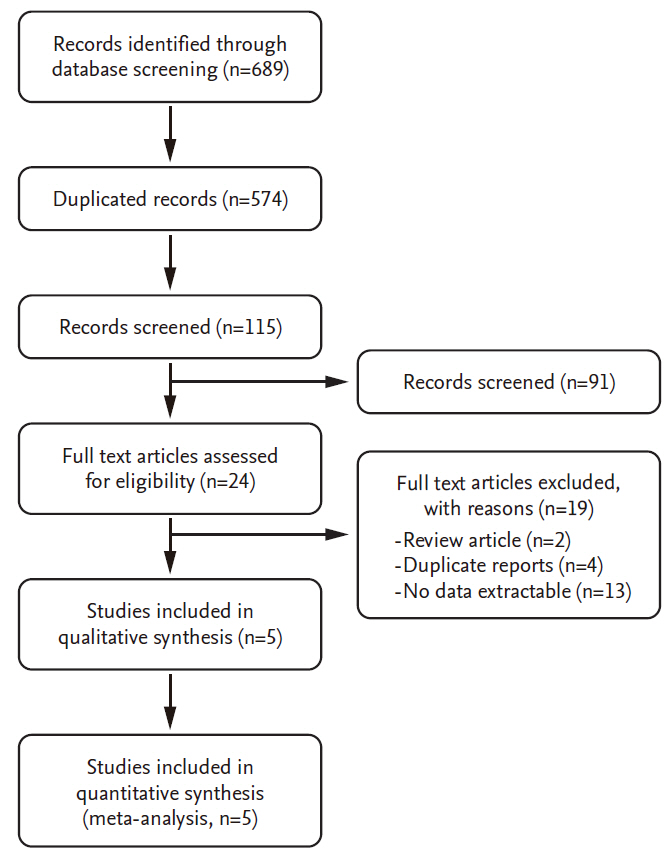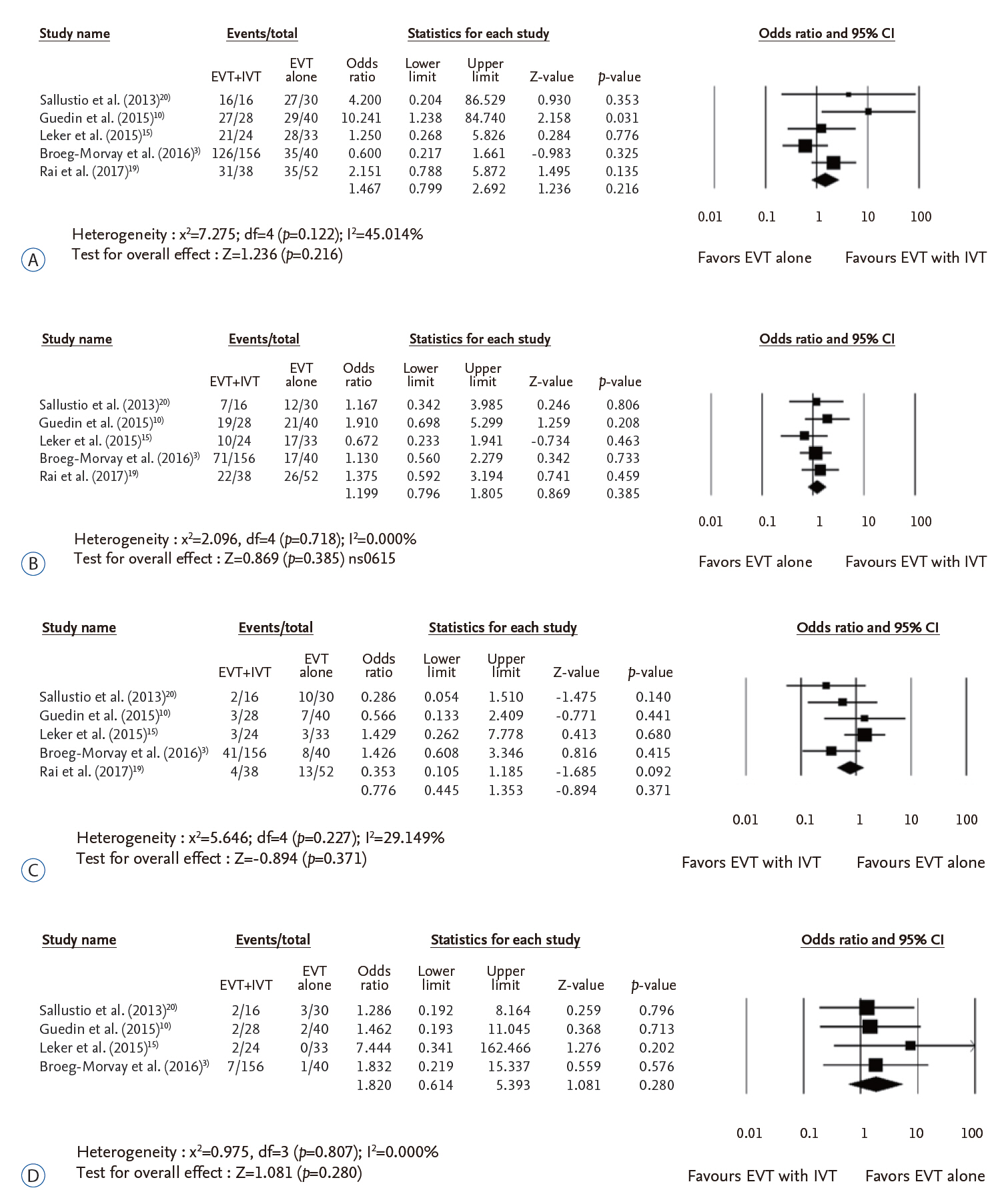Endovascular Treatment with Intravenous Thrombolysis versus Endovascular Treatment Alone for Acute Anterior Circulation Stroke : A Meta-Analysis of Observational Studies
- Affiliations
-
- 1Department of Neurology, Hallym University College of Medicine, Chuncheon, Korea.
- 2Department of Neurosurgery, Hallym University College of Medicine, Chuncheon, Korea. jjs6553@daum.net
- 3Institute of New Frontier Research, Hallym University College of Medicine, Chuncheon, Korea.
- 4Department of Emergency Medicine, Seoul Emergency Operations Center, Seoul, Korea.
- KMID: 2417322
- DOI: http://doi.org/10.3340/jkns.2017.0505.006
Abstract
OBJECTIVE
The aim of this study was to determine outcome of ischemic stroke patients in the anterior circulation treated with endovascular treatment (EVT) with intravenous thrombolysis (IVT) versus EVT alone group.
METHODS
A systemic literature review was performed using online database from January 2004 to January 2017. Primary outcomes were successful recanalization seen on finial angiography and good outcome at three months. Secondary outcomes were mortality and the development of symptomatic intracranial hemorrhage (S-ICH) after the procedure. A fixed effect model was used when heterogeneity was less than 50%. Egger's regression test was used to assess publication bias.
RESULTS
Five studies were included for final analysis. Between EVT with IVT and EVT alone group, successful recanalization (odds ratio [OR] 1.467, p=0.216), good clinical outcome at three months (OR 1.199, p=0.385), mortality (OR 0.776, p=0.371), and S-ICH (OR 1.820, p=0.280) did not differ significantly. Egger's regression intercept with 95% confidence interval (CI) was 1.99 (95% CI -2.91 to 6.89) in successful recanalization and -0.27 (95% CI -6.35 to 5.80) in good clinical outcome, respectively.
CONCLUSION
The two treatment modalities, EVT with IVT and EVT alone, could be comparable in treating acute anterior circulation stroke. Studies to find specific beneficiary group for EVT alone, without primary IVT, are needed further.
MeSH Terms
Figure
Cited by 4 articles
-
Influence of Anesthesia Type on Outcomes after Endovascular Treatment in Acute Ischemic Stroke: Meta-Analysis
Chulho Kim, Sung-Eun Kim, Jin Pyeong Jeon
Neurointervention. 2019;14(1):17-26. doi: 10.5469/neuroint.2019.00045.The Effects of Balloon-Guide Catheters on Outcomes after Mechanical Thrombectomy in Acute Ischemic Strokes : A Meta-Analysis
Jun Hyong Ahn, Steve S. Cho, Sung-Eun Kim, Heung Cheol Kim, Jin Pyeong Jeon
J Korean Neurosurg Soc. 2019;62(4):389-397. doi: 10.3340/jkns.2018.0165.A Preliminary Study of the Association between
SOX17 Gene Variants and Intracranial Aneurysms Using Exome Sequencing
Jeong Jin Park, Bong Jun Kim, Dong Hyuk Youn, Hyuk Jai Choi, Jin Pyeong Jeon
J Korean Neurosurg Soc. 2020;63(5):539-549. doi: 10.3340/jkns.2019.0225.Profiling of T Cell Receptor β-Chain Complimentary Determining Regions 3 Repertoire in Subarachnoid Hemorrhage Patients Using High-Throughput Sequencing
Bong Jun Kim, Jun Hyong Ahn, Dong Hyuk Youn, Jin Pyeong Jeon
J Korean Neurosurg Soc. 2021;64(4):505-513. doi: 10.3340/jkns.2020.0214.
Reference
-
References
1. Almekhlafi MA, Menon BK, Freiheit EA, Demchuk AM, Goyal M. A meta-analysis of observational intra-arterial stroke therapy studies using the Merci device, penumbra system, and retrievable stents. AJNR Am J Neuroradiol. 34:140–145. 2013.
Article2. Begg CB, Mazumdar M. Operating characteristics of a rank correlation test for publication bias. Biometrics. 50:1088–1101. 1994.
Article3. Broeg-Morvay A, Mordasini P, Bernasconi C, Buhlmann M, Pult F, Arnold M, et al. Direct mechanical intervention versus combined intravenous and mechanical intervention in large artery anterior circulation stroke: a matched-pairs analysis. Stroke. 47:1037–1044. 2016.
Article4. Broussalis E, Trinka E, Hitzl W, Wallner A, Chroust V, Killer-Oberpfalzer M. Comparison of stent-retriever devices versus the Merci retriever for endovascular treatment of acute stroke. AJNR Am J Neuroradiol. 34:366–372. 2013.
Article5. Bush CK, Kurimella D, Cross LJ, Conner KR, Martin-Schild S, He J, et al. Endovascular treatment with stent-retriever devices for acute ischemic stroke: a meta-analysis of randomized controlled trials. PloS One. 11:e0147287. 2016.
Article6. Dávalos A, Pereira VM, Chapot R, Bonafé A, Andersson T, Gralla J, et al. Retrospective multicenter study of Solitaire FR for revascularization in the treatment of acute ischemic stroke. Stroke. 43:2699–2705. 2012.
Article7. González RG, Furie KL, Goldmacher GV, Smith WS, Kamalian S, Payabvash S, et al. Good outcome rate of 35% in IV-tPA-treated patients with computed tomography angiography confirmed severe anterior circulation occlusive stroke. Stroke. 44:3109–3113. 2013.
Article8. Goyal M, Menon BK, van Zwam WH, Dippel DW, Mitchell PJ, Demchuk AM, et al. Endovascular thrombectomy after large-vessel ischaemic stroke: a meta-analysis of individual patient data from five randomised trials. Lancet. 387:1723–1731. 2016.
Article9. Grech R, Pullicino R, Thornton J, Downer J. An efficacy and safety omparison between different stentriever designs in acute ischaemic stroke: a systematic review and meta-analysis. Clin Radiol. 71:48–57. 2016.
Article10. Guedin P, Larcher A, Decroix JP, Labreuche J, Dreyfus JF, Evrard S, et al. Prior IV thrombolysis facilitates mechanical thrombectomy in acute ischemic stroke. J Stroke Cerebrovasc Dis. 24:952–957. 2015.
Article11. Jeon JP, Kim JE. A recent update of clinical and research topics concerning adult moyamoya disease. J Korean Neurosurg Soc. 59:537–543. 2016.
Article12. Kaesmacher J, Kleine JF. Bridging therapy with i. v. rtPA in MCA occlusion prior to endovascular thrombectomy: a double-edged sword? Clin Neuroradiol. 28:81–89. 2018.
Article13. Kass-Hout T, Kass-Hout O, Mokin M, Thesier DM, Yashar P, Orion D, et al. Is bridging with intravenous thrombolysis of any benefit in endovascular therapy for acute ischemic stroke? World Neurosurg. 82:e453–e458. 2014.
Article14. Lapergue B, Blanc R, Guedin P, Decroix JP, Labreuche J, Preda C, et al. A direct aspiration, first pass technique (ADAPT) versus stent retrievers for acute stroke therapy: an observational comparative study. AJNR Am J Neuroradiol. 37:1860–1865. 2016.
Article15. Leker RR, Pikis S, Gomori JM, Cohen JE. Is bridging necessary? A pilot study of bridging versus primary stentriever-based endovascular reperfusion in large anterior circulation strokes. J Stroke Cerebrovasc Dis. 24:1163–1167. 2015.
Article16. Ma QF, Chu CB, Song HQ. Intravenous versus intra-arterial thrombolysis in ischemic stroke: a systematic review and meta-analysis. PloS One. 10:e0116120. 2015.
Article17. Maier IL, Behme D, Schnieder M, Tsogkas I, Schregel K, Kleinknecht A, et al. Bridging-therapy with intravenous recombinant tissue plasminogen activator improves functional outcome in patients with endovascular treatment in acute stroke. J Neurol Sci. 372:300–304. 2017.
Article18. Qian C, Yu X, Li J, Chen J, Wang L, Chen G. The efficacy of surgical treatment for the secondary prevention of stroke in symptomatic moyamoya disease: a meta-analysis. Medicine (Baltimore). 94:e2218. 2015.19. Rai AT, Boo S, Buseman C, Adcock AK, Tarabishy AR, Miller MM, et al. Intravenous thrombolysis before endovascular therapy for large vessel strokes can lead to significantly higher hospital costs without improving outcomes. J Neurointerv Surg. 10:17–21. 2018.
Article20. Sallustio F, Koch G, Di Legge S, Rossi C, Rizzato B, Napolitano S, et al. Intra-arterial thrombectomy versus standard intravenous thrombolysis in patients with anterior circulation stroke caused by intracranial arterial occlusions: a single-center experience. J Stroke Cerebrovasc Dis. 22:e323–e331. 2013.
Article21. Weber R, Nordmeyer H, Hadisurya J, Heddier M, Stauder M, Stracke P, et al. Comparison of outcome and interventional complication rate in patients with acute stroke treated with mechanical thrombectomy with and without bridging thrombolysis. J Neurointerv Surg. 9:229–233. 2017.
Article
- Full Text Links
- Actions
-
Cited
- CITED
-
- Close
- Share
- Similar articles
-
- Intravenous Thrombolysis and Endovascular Thrombectomy in Acute Ischemic Stroke with Minor Symptom
- Intravenous Versus Intra-arterial Thrombolysis for Acute Ischemic Stroke Secondary to Basilar Artery Occlusion
- Causes and Solutions of Endovascular Treatment Failure
- Endovascular Treatment of Acute Ischemic Stroke
- Evolution of Endovascular Therapy in Acute Stroke: Implications of Device Development



